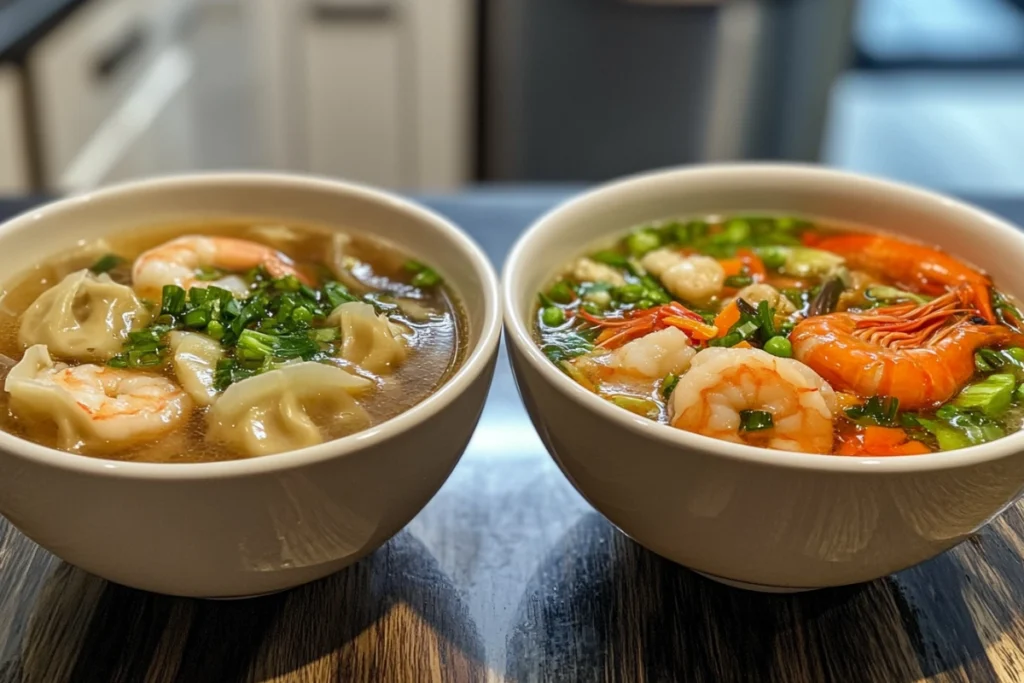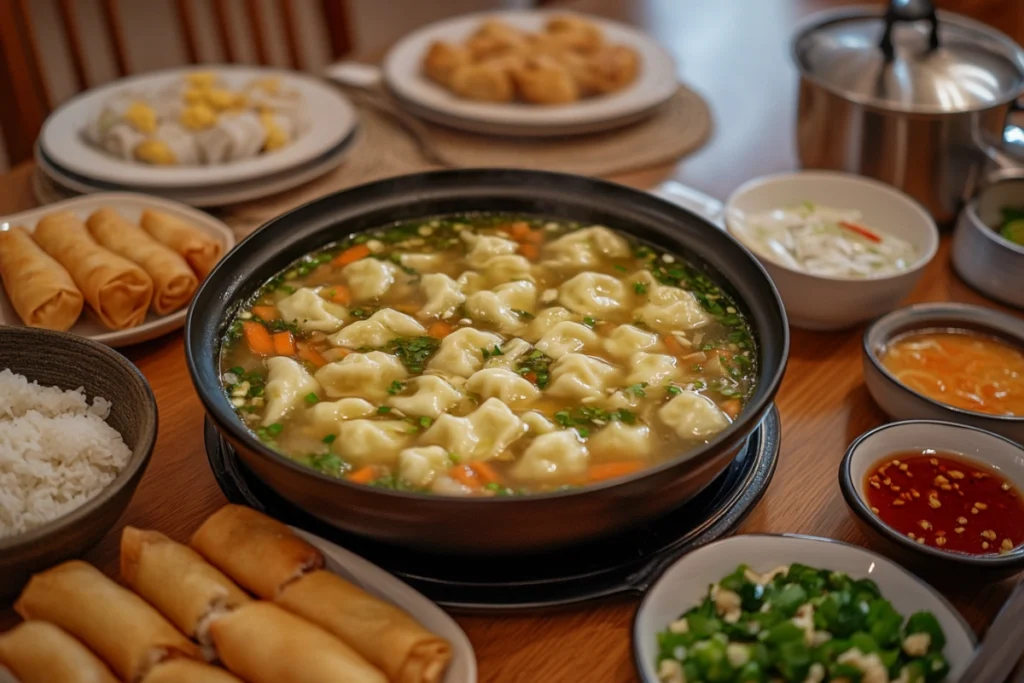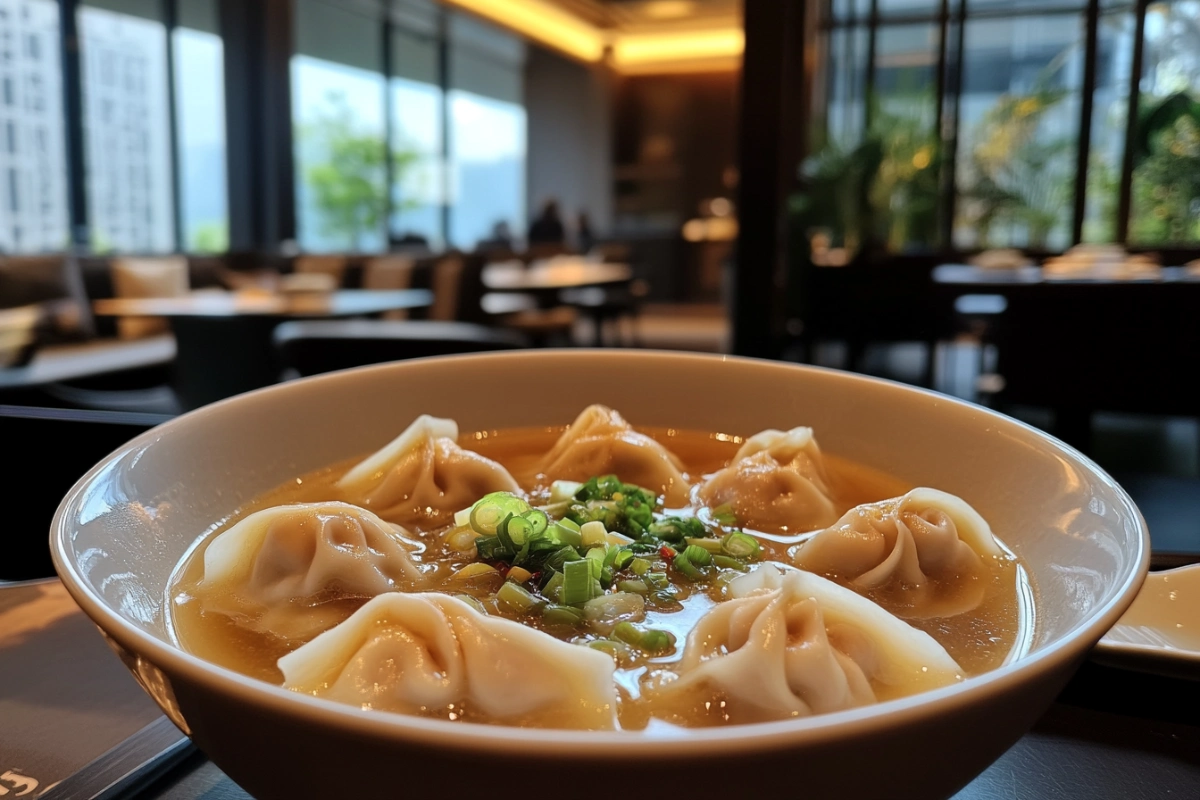When it comes to comforting Chinese cuisine, many wonder, what’s the difference between wonton soup and war wonton soup? These two soups are delicious and hearty choices with distinct characteristics.While these dishes may seem similar at first glance, a closer look reveals intriguing distinctions in their ingredients, preparation, and overall appeal. This article dives into the key differences between these two soups, exploring everything from their origins to their nutritional profiles. Whether you’re curious about their history or need help choosing the right dish for your meal, this guide has you covered.
Introduction to Wonton Soup and War Wonton Soup
What is Wonton Soup?
Wonton soup is a simple yet flavorful dish that has been a staple of Chinese cuisine for centuries. At its core, it features delicate wontons—small dumplings filled with seasoned ground meat or shrimp—served in a light and savory broth. Traditionally, the dumplings are made with thin wheat wrappers that become silky and tender when cooked.
This humble soup is often enjoyed as an appetizer or light meal due to its straightforward preparation and comforting taste. Its origins can be traced back to southern China, where it was considered a common food among the working class. Over time, wonton soup has gained global popularity, often adapted to suit regional preferences.
What is War Wonton Soup?
In contrast, war wonton soup takes the basic wonton soup concept and elevates it with an array of ingredients. The term “war” is believed to stem from the Cantonese word for “everything,” highlighting the soup’s rich and diverse composition. Alongside the signature wontons, war wonton soup often includes chicken, shrimp,or beef, as well as a vibrant assortment of vegetables such as bok choy, mushrooms, carrots, and broccoli.
This hearty variation is more than just a soup—it’s a meal in itself. Popular in Chinese-American restaurants, war wonton soup has become a go-to dish for those craving a satisfying, nutrient-packed bowl of comfort food.
Key Differences Between Wonton Soup and War Wonton Soup
Ingredients and Add-ons
If you’ve ever asked, what’s the difference between wonton soup and war wonton soup?, the answer starts with their ingredients. Wonton soup keeps it simple, showcasing its namesake dumplings as the centerpiece. These dumplings are typically filled with ground beef, shrimp, or a combination of both, served in a delicate, clear broth. Occasionally, some scallions or a few sprigs of cilantro are added for garnish.
On the other hand, war wonton soup is a robust feast for the senses. Alongside wontons, it features a medley of proteins such as chicken, beef, and shrimp. The soup is further enriched with a vibrant assortment of vegetables—bok choy, carrots, broccoli, mushrooms, and more—making it a heartier, more complex dish. This diversity of ingredients ensures that war wonton soup can easily serve as a complete meal.

Preparation Techniques
The simplicity of wonton soup extends to its preparation. The wontons are boiled or steamed until tender, then gently placed in a light broth. This method highlights the dumplings’ delicate flavor, making it a dish that’s easy to prepare and enjoy.
In contrast, preparing war wonton soup requires a bit more time and effort. Each ingredient is cooked separately to preserve its texture and flavor before being combined into the broth. The result is a rich, layered dish that feels more substantial and indulgent. This difference in preparation reflects the soup’s role as a celebratory or special-occasion meal in Chinese cuisine.
If you’re curious about variations, consider reading Subgum Wonton Soup: A Colorful and Comforting Dish for an exploration of how additional ingredients can elevate a traditional wonton base.
Nutritional Comparison
Calorie Count and Macronutrients
When comparing the nutritional profiles, wonton soup is typically lighter in calories. A standard serving contains around 200-300 calories, depending on the filling and broth. The dish’s minimal ingredients make it an excellent choice for those looking for a low-calorie, protein-rich option.
War wonton soup, however, is a more calorie-dense meal, ranging from 400 to 600 calories per serving. The variety of proteins, vegetables, and sometimes noodles or rice contributes to its higher nutritional value. This soup is rich in vitamins and minerals, thanks to its diverse mix of fresh ingredients.
Nutritional Content (Per 100g)
Below is a detailed breakdown of their nutritional values:
| Nutrient | Wonton Soup | War Wonton Soup |
|---|---|---|
| Calories | 80 kcal | 110 kcal |
| Protein | 4 g | 7 g |
| Fat | 2 g | 4 g |
| Carbohydrates | 8 g | 9 g |
| Sodium | 480 mg | 680 mg |
| Fiber | 1 g | 2 g |
| Vitamins (A, C) | Low | Moderate |
Health Benefits and Considerations
Both soups offer health benefits, but their appeal depends on dietary needs. The simplicity of wonton soup makes it easier to control sodium and fat content. It’s a go-to for a lighter, more straightforward meal.
Meanwhile, war wonton soup stands out as a balanced and nutrient-packed option. Its protein diversity supports muscle repair and growth, while the vegetables provide essential vitamins and fiber. However, the dish’s complexity can sometimes lead to higher sodium levels, so moderation is key.
Popularity and Global Variations
Wonton Soup Around the World
The popularity of both soups often raises the question, what’s the difference between wonton soup and war wonton soup? Wonton soup, with its simple ingredients, has become a global favorite, while war wonton soup shines as a hearty, complete meal. The simplicity of its preparation makes it adaptable to various cuisines. In the United States, wonton soup is a staple on Chinese-American restaurant menus, often enjoyed as a light starter before heartier dishes.
In other parts of the world, the soup has taken on unique regional flavors. For example, in Southeast Asia, wonton soup may be infused with lemongrass or chili for a spicy twist. Similarly, European versions might feature creamy broth variations or alternative fillings like cheese or vegetables. These adaptations speak to the soup’s versatility and universal appeal.
War Wonton Soup’s Appeal
On the other hand, war wonton soup is celebrated for its heartiness and rich flavors. It is particularly popular in Chinese-American cuisine, where diners appreciate its ability to serve as a full meal. The soup’s mix of proteins and vegetables makes it a go-to option for those seeking a healthy yet satisfying dish.
Interestingly, the name “war wonton” often sparks curiosity. This hearty dish reflects the “everything but the kitchen sink” approach, which has endeared it to food enthusiasts worldwide. For a closer look at other hearty Chinese soups, you might enjoy Subgum Wonton Soup: A Colorful and Comforting Dish.
Culinary Context and Serving Occasions

When to Choose Wonton Soup?
If you’re in the mood for a simple, comforting dish, wonton soup is the perfect choice. Its light and clean flavor profile makes it an excellent starter for any meal or a gentle pick-me-up when you’re feeling under the weather. Moreover, the broth’s clarity and the dumplings’ soft texture make it a favorite among those looking for a minimalist yet satisfying meal.
When to Choose War Wonton Soup?
When deciding between these soups, understanding what’s the difference between wonton soup and war wonton soup? can help. War wonton soup is the ideal option for robust dining occasions. This soup is a crowd-pleaser for family dinners, celebrations, or when you’re simply craving something hearty. Its layers of flavors and variety of textures make it a complete dish that can easily stand on its own.
For more delicious and comforting meal ideas, check out our collection of hearty soup recipes on Medium Recipes. Whether you’re exploring traditional flavors or innovative twists, there’s something to suit every taste.
FAQs
Is War Wonton Soup Healthier Than Regular Wonton Soup?
The answer depends on your dietary goals. Wonton soup is generally lighter and lower in calories because it features a clear broth and fewer ingredients. In contrast, war wonton soup includes a variety of proteins and vegetables, offering a more nutrient-dense option. While this makes war wonton soup more filling and balanced, it can also be higher in sodium and calories. If you’re aiming for a low-calorie meal, wonton soup is a great choice. However, if you’re looking for a complete dish with a variety of nutrients, war wonton soup takes the lead.
Can You Substitute One for the Other in Recipes?
While you can technically substitute wonton soup for war wonton soup in recipes, the results won’t be identical. Wonton soup is simpler and works best as an appetizer or light meal. War wonton soup, on the other hand, is designed to be a hearty main course. If you’re cooking and want to transition from one to the other, consider adding more vegetables and proteins to wonton soup to create a war wonton-style dish.
What Makes War Wonton Soup More Filling?
The key lies in its ingredients. War wonton soup incorporates chicken, shrimp, and beef along with hearty vegetables like bok choy and mushrooms, making it much more substantial. By comparison, wonton soup focuses primarily on the dumplings and broth, making it a lighter option.
Why Is War Wonton Soup Called “War”?
The term “war” is derived from the Cantonese word for “everything” (wah), reflecting the soup’s inclusion of a wide range of ingredients. The name emphasizes the dish’s abundance and complexity, a stark contrast to the simpler wonton soup.
Conclusion
If you’ve ever wondered, what’s the difference between wonton soup and war wonton soup?, the answer lies in their purpose and composition. Wonton soup is a minimalist, comforting dish that highlights the simplicity of dumplings in a clear broth. It’s perfect for those seeking a light, wholesome meal or appetizer.
War wonton soup, on the other hand, is a vibrant and hearty meal in a bowl. Its diverse array of proteins, vegetables, and complex flavors make it a crowd-pleasing choice for a satisfying main course. While the two share a base concept, their ingredients and preparation techniques cater to different occasions and preferences.
Whether you’re in the mood for something light or hearty, both soups offer unique flavors and textures to suit your cravings. Next time you’re exploring Chinese cuisine, take a moment to savor the distinct characteristics of each dish—you’ll appreciate their individual charm even more.
For more delicious Chinese recipes and cooking tips, explore our curated collection at Medium Recipes. Happy cooking!
Cooking Tips for Wonton and War Wonton Soup
Perfecting Wonton Soup
If you’re making wonton soup at home, focusing on the quality of the dumplings is key. Use fresh ingredients for the filling—ground beef, shrimp, or a mix of both—seasoned with ginger, soy sauce, and sesame oil for a flavorful punch. Ensure the wonton wrappers are sealed properly to prevent them from opening during cooking.
For the broth, simplicity is best. A light chicken or vegetable broth seasoned with a touch of soy sauce and white pepper complements the delicate dumplings. Adding chopped scallions or a sprinkle of cilantro as a garnish enhances the dish without overpowering its subtle flavors.
Tips for War Wonton Soup
Making war wonton soup requires a bit more effort, but the results are worth it. Start by preparing the wontons as described above, then focus on assembling the rest of the ingredients. Use a mix of proteins like chicken, shrimp, or beef, cooked separately to retain their individual flavors.
When choosing vegetables, aim for variety. Bok choy, mushrooms, carrots, and broccoli are excellent options. Cook each vegetable lightly to preserve its texture and color before adding them to the broth. Finally, combine everything in a rich chicken or beef stock for a meal that’s as filling as it is flavorful.
For more inspiration on hearty soups, check out Subgum Wonton Soup: A Colorful and Comforting Dish.
Pairing and Serving Suggestions
Pairing Wonton Soup
Wonton soup is a versatile dish that pairs well with various sides. Serve it alongside steamed rice or light appetizers like spring rolls for a balanced meal. Its light flavor also makes it an excellent companion to spicier main dishes, helping to cleanse the palate.
Pairing War Wonton Soup
War wonton soup is hearty enough to be a standalone dish, but it also pairs beautifully with Chinese-style pancakes, crispy noodles, or dim sum for a festive meal. To enhance its rich flavors, consider serving it with a side of chili oil or a splash of soy sauce.
For a complete dining experience, try complementing either soup with jasmine tea or a light Chinese dessert like mango pudding. These pairings elevate the flavors and provide a delightful end to your meal.
Now that you know what’s the difference between wonton soup and war wonton soup?, you can confidently prepare and serve these dishes for any occasion.
Conclusion
In the world of comforting soups, both wonton soup and war wonton soup offer their own unique appeal. If you’ve ever wondered, what’s the difference between wonton soup and war wonton soup?, the answer lies in their simplicity versus complexity. Wonton soup is a light, straightforward dish that focuses on the delicate flavors of wontons in a clear broth. It’s a perfect choice for those seeking a quick and comforting meal or appetizer.
Meanwhile, war wonton soup transforms this classic dish into a hearty, well-rounded meal by incorporating an abundance of proteins and vegetables. This vibrant soup is ideal for special occasions or whenever you crave something substantial and satisfying.
Nutritionally, wonton soup is the lighter option, while war wonton soup packs more nutrients but comes with higher calories and sodium. Whether you’re dining out or cooking at home, the choice between these soups depends on your preferences, occasion, and dietary goals.
So next time you’re exploring Chinese cuisine, take a moment to savor the distinct characteristics of each. Both soups are delicious in their own right and showcase the versatility and depth of traditional and modern Chinese cooking.
For more recipes and tips to elevate your cooking, visit Medium Recipes and explore a world of flavors waiting to be discovered!

